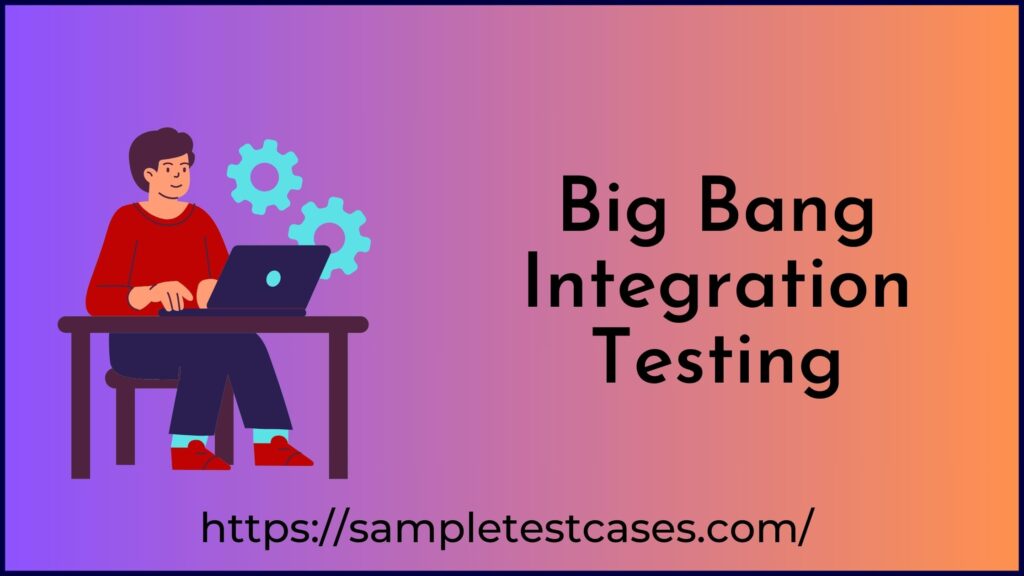In this article, we’ll explore what Big Bang Integration Testing is, its advantages, best practices, and when to use it in the software development lifecycle. In the world of software development, integrating individual components or modules into a cohesive application is a critical phase. This integration process ensures that the various parts of the software work harmoniously together. One approach to integration testing, known as Big Bang Integration Testing, stands out for its simplicity and efficiency.
What is Big Bang Integration Testing?
Big Bang Integration Testing is a testing methodology where all the components or modules of a software application are integrated simultaneously and tested as a whole. In other words, rather than incrementally integrating and testing individual parts of the application, all the components are combined at once, and their interactions and functionality are assessed collectively.
This approach typically occurs after the individual units or components have undergone unit testing. Once these units are ready for integration, they combine in a “big bang,” and testing conduct on the complete system.
Advantages of Big Bang Integration Testing
This testing offers several advantages:
- Simplicity: It’s a straightforward approach that doesn’t require the gradual integration of components, which can be complex and time-consuming.
- Quick Integration: Since all components integrate simultaneously, the integration phase can complete relatively quickly.
- Identifying Major Issues: Big Bang testing can uncover major integration issues early in the development process, allowing for timely resolution.
- Independence: Developers can work on individual components independently without worrying about the integration process until it’s time for Big Bang Testing.
- Efficiency: It’s efficient when the application’s components are relatively stable and well-understood.
Best Practices for Big Bang Integration Testing
To make the most of this testing, consider the following best practices:
- Clear Test Objectives: Define clear objectives and criteria for what constitutes a successful integration test.
- Thorough Unit Testing: Ensure that individual components or units have undergone rigorous unit testing to minimize issues during the Big Bang.
- Comprehensive Test Data: Prepare comprehensive test data that covers a wide range of scenarios and use cases.
- Integration Test Plan: Create a detailed test plan that outlines the sequence of integration and the specific tests to conduct.
- Logging and Monitoring: Implement robust logging and monitoring mechanisms to track the behavior of the integrated system during testing.
- Environment Simulation: Simulate the production environment as closely as possible to replicate real-world conditions.
- Rollback Strategy: Develop a rollback strategy in case significant issues identifie during testing.
- Defect Tracking: Use a defect tracking system to log and prioritize issues found during this testing.
When to Use Big Bang Integration Testing
This testing is a suitable approach in certain situations:
- Small to Medium-Sized Projects: It works well for projects with a limited number of components or modules that can easily manage in a single integration phase.
- Stable Components: When the individual components stable, well-test, and their interfaces are well-defined.
- Early Integration: In cases where the integration phase occurs relatively early in the development process, allowing for early detection and resolution of integration issues.
- Rapid Development: In agile or iterative development environments where components are continuously evolving and need to be integrated periodically.
Limitations and Considerations
While this testing has its advantages, it’s not suitable for every project:
- Risk: There is a higher risk of discovering major integration issues late in the development process.
- Complexity: For large and complex systems, This testing can be challenging to manage and debug.
- Limited Traceability: It may be more challenging to trace defects back to specific components, as everything integrate simultaneously.
- Resource Intensive: The approach may require significant resources and effort to address any issues that arise during testing.
Conclusion
Big Bang Integration Testing is a valuable approach when applied in the right context. It simplifies the integration process and can quickly identify major integration issues. However, it is essential to carefully plan and prepare for Big Bang Testing, ensuring that individual components are well-tested and that the objectives and criteria for successful integration are clearly defined. When used judiciously, This testing can contribute to a smoother and more efficient software development process.
